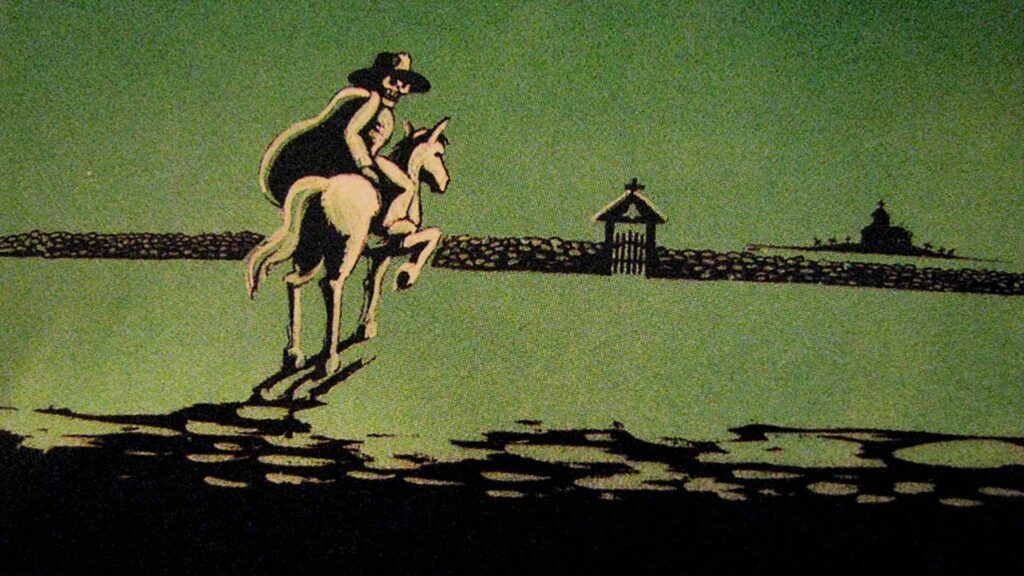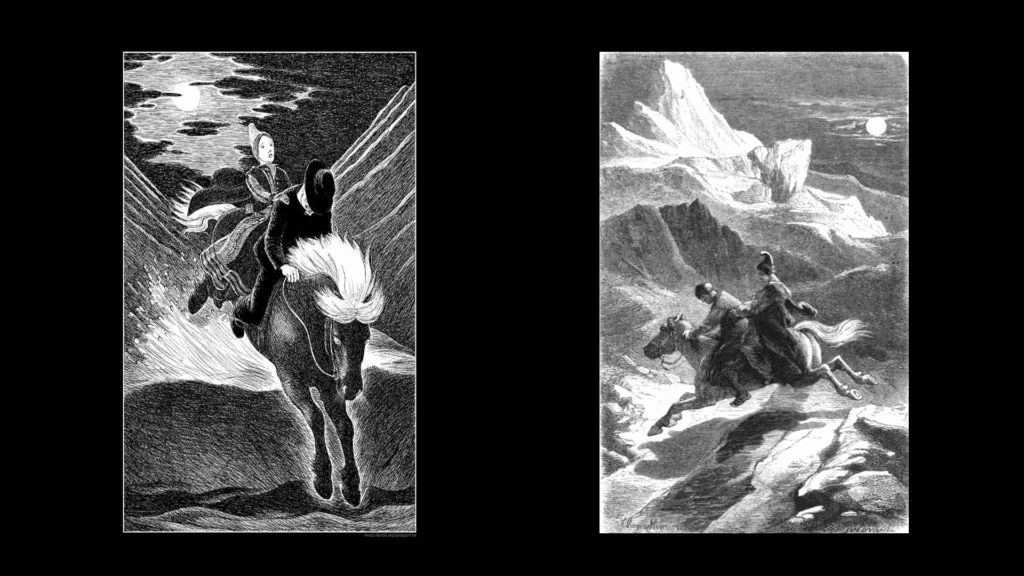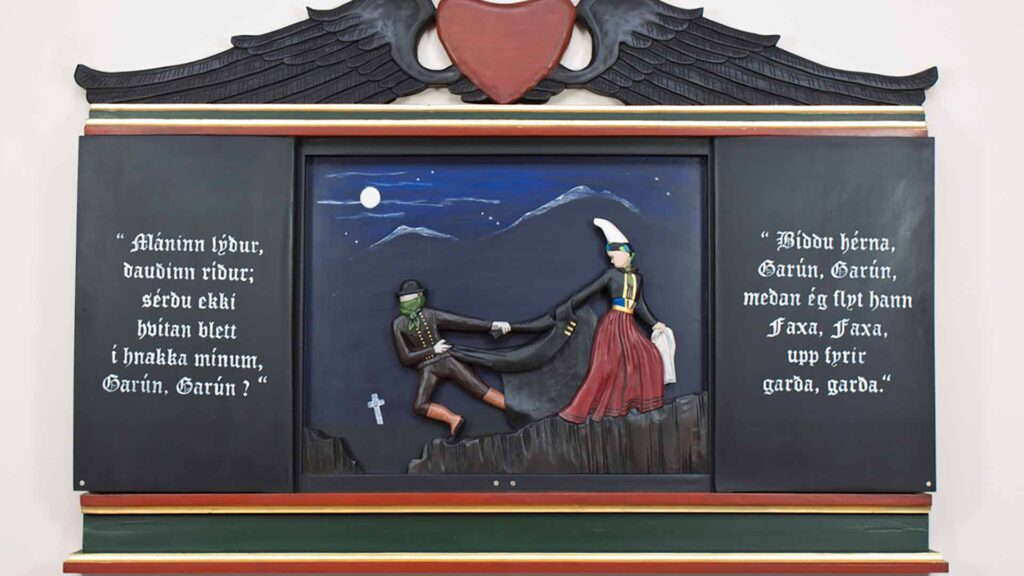Icelandic ghost story The Deacon of Myrká is one of the country’s most famous stories. First published in Jón Árnason’s Folktales and Legends in the 19th century. The folktale has been an inspiration for many artists in Iceland, and in the late 80s, a modern depiction of the story was made into a film. One of Iceland’s most popular bands also wrote a song called “Garún Garún“.
You can learn more about Icelandic ghost stories and folktales on our Reykjavik Folklore Walking Tour!
Read more about Icelandic ghosts, spectres and zombies here.
Read other fairytales and legends:
- Sæmundur the Learned and the Devil
- The Shepherd of Silfrúnarstaðir
- The Genesis of the Hidden People
- The Tale of Búkolla – Version 1 and 2
- White Cap
- Dear Mother in the Pen, Pen
- The Story of Mjaðveig Mánadóttir
- The Bishop and The Elves
- Katla’s Dream
- Now I should laugh if I were not dead!
- The Story of Bergþór of Bláfell
- The Merman
- Móhúsa-Skotta
- “The Darkness is Fun”
- The Sorcerers in The Westman Islands
- The Two Sigurds
- The Merman
- The Manservant and the Water-Elves
- Gold Brow
- Úlfsvatn
The Deacon of Myrká
A long time ago, a deacon lived at Myrká in Eyjaförður. He was in love with a girl named Guðrún, who dwelt on a farm on the opposite side of the valley, separated from his house by a river.
The deacon had a horse with a grey mane, which he was always in the habit of riding. He called it Faxi.
A short time before Christmas, the deacon rode to the farm where his betrothed lived and invited her to join in the Christmas festivities at Myrká, promising to fetch her on Christmas eve. Sometime before he had started out on this ride, there had been heavy snow and frost. But this very day, there came so rapid a thaw that the river over which the deacon had safely ridden, trusting to the firmness of the ice, became impassable during the short time he spent with his betrothed; the floods rose, and huge masses of drift-ice were whirled down the stream.
When the deacon had left the farm, he rode on to the river and, deep in thought, did not initially perceive the change that had taken place. As soon as he saw in what state the stream was, he rode up the banks until he came to a bridge of ice, on which he spurred his horse. But when he arrived at the middle of the bridge, it broke beneath him, and he was drowned in the flood.

A neighbouring farmer saw the deacon’s horse grazing in a field the following day. However, he could discover nothing of its owner, whom he had seen the day before crossing the river but not return. He at once suspected what had occurred and, going down to the river, found the corpse of the deacon, which had drifted to the bank, with all the flesh torn off the back of his head, and the bare white skull visible. So, he brought the body back to Myrká, where it was buried a week before Christmas.
Up to Christmas eve, the river continued so swollen that no communication could take place between the dwellers on the opposite banks, but that morning it subsided, and Guðrún, utterly ignorant of the deacon’s death, looked forward with joy to the festivities to which he had invited her.
In the afternoon, Guðrún began to dress in her best clothes, but she heard a knock at the farm’s door before she had finished. One of the maidservants opened the door but, seeing nobody there, thought it was because the night was not sufficiently light, for the moon was hidden for the time by clouds. So saying, “Wait there till I bring a light,” she went back into the house; but she had no sooner shut the outer door behind her than the knock was repeated, and Guðrún cried out from her room, “It is someone waiting for me.”
As she had by this time finished dressing, she slipped only one sleeve of her winter cloak on and threw the rest over her shoulders hurriedly. When she opened the door, she saw the well-known Faxi standing outside and by him a man whom she knew to be the deacon. Without a word, he placed Guðrún on the horse, mounted in front of her himself, and rode off.

When they came to the river, it was frozen over, all except the current in the middle, which the frost had not yet hardened. The horse walked onto the ice and leapt over the black and rapid stream which flowed in the middle. At the exact moment, the head of the deacon nodded forward so that his hat fell over his eyes, and Guðrún saw the large patch of bare skull gleaming white in his hair. Directly afterwards, a cloud moved from before the moon, and the deacon said —
"The moon glides, Death rides,
Seest thou not the white place
In the back of my head,
Garún, Garún?"
No more was spoken until they came to Myrká, where they dismounted. Then the man said:
"Wait here for me, Garun, Garun,
While I am taking Faxi, Faxi,
Outside the hedges, the hedges!"
When he had gone, Guðrún saw near her in the churchyard where she was standing an open grave; half sick with horror, she ran to the church porch and, seizing the rope, tolled the bells with all her strength. But as she began to ring them, she felt someone grasp her and full so fiercely at her cloak that it was torn off her, leaving only the one sleeve into which she had thrust her arm before starting from home. Then turning round, she saw the deacon jump headlong into the yawning grave, with the tattered cloak in his hand, and the heaps of earth on both sides fall in over him and close the grave up to the brink.

Guðrún knew now that it was the deacon’s ghost with whom she had had to do and continued ringing the bells till she roused all the farm servants at Myrká.
That same night, after Guðrún had got shelter at Myrká and was in bed, the deacon came again from his grave and endeavoured to drag her away so that no one could sleep for the noise of their struggle.
This was repeated every night for a fortnight. Guðrún could never be left alone for a single instant, lest the goblin deacon should get the better of her. From time to time, also, a neighbouring priest came and sat on the edge of the bed, reading the Psalms of David to protect her against this ghostly persecution.
But nothing availed till they sent for a man from the north country, skilled in witchcraft, who dug up a large stone from the field and placed it in the middle of the guestroom at Myrká. When the deacon rose that night from his grave and came into the house to torment Guðrún, this man seized him and, by uttering potent spells over him, forced him beneath the stone and exorcised the passionate demon that possessed him so that there he lies in peace to this day.
We hope you liked this famous Icelandic ghost story. Ghost stories are generally very popular in Iceland, probably due to the darkness and mysticism of our little island.
Guðrún’s name means God Rune, and according to Icelandic folktales, ghosts cannot say “god”, so that’s why the deacon addressed her as Garún in the poem.
Please signup HERE for our newsletter for more fun facts and information about Iceland!









